
| HOME | BOOKS | ABOUT US | CONTACT US | ARTICLES | CLIENT LIST | LINKS |
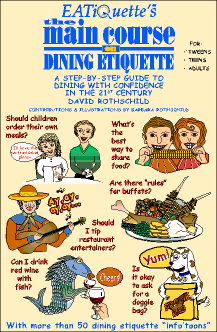
You'll find 59 dining etiquette "info'toons" in EATiQuette's The Main Course on Dining Etiquette.
Here are some info'toons that appeared on our site following the publication of the book.
Please check back often as we'll occasionally be adding more.
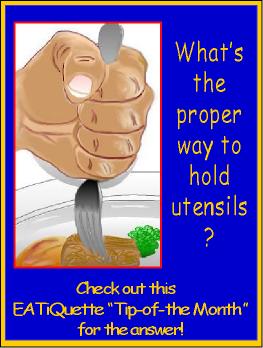 |
As you might have guessed, the way that's shown above is not the proper way to hold a fork (or knife or spoon). Dagger-style, golf club and baseball bat grips are out. The correct way to hold a fork is more like a pencil grip, with the tip of the index finger resting near the end of the handle closest to the tines, the end of your thumb touching the "pad" of your index finger with the fork handle resting on your middle finger. A spoon is held the same way. When using your fork and knife to cut meat or other foods, place the tip of your index finger (with your finger held straight) near the base of the handle on the back of the fork (so the tines are facing down). The handle of the fork is cradled in the palm of your hand with your thumb and middle finger grasping the sides of the handle. Use the same grip for the knife. An old Tiffany's Table Manners for Teenagers tells the reader not to hold utensils "like a mashie niblick." We're not golfers, so we don't quite understand what they mean. But we'll take their word for it -- don't do it! Question for you . . . Do you hold your utensils with your forefinger (index finger) curled around the end? If so, can you tell us how you learned this? Do you have any idea how this utensil hold first started or came about? Please let us know your thoughts and experiences. We're dying to find out the origin of this grip! Thanks in advance for any info you can share at info@eatiquette.com |
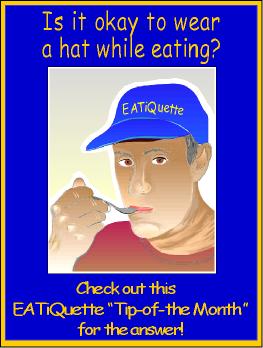 |
Women are allowed to wear hats while dining, even indoors, but this should be reserved for formal functions and afternoon teas. Women, too, should refrain from wearing baseball-style caps in the dining room. We understand, from several sources on the internet, that the practice of men removing their hats is based in chivalry. Knights appeared quite menacing when fully suited in armor so, to indicate that they were a person's (especially a woman's) friend instead of a foe, they removed their helmets. A couple of other hat-related anecdotes we came across... From a letter to "Miss Manners": ...You may recall that when (football coach) Bear Bryant was asked why he didn't wear his trademark hat in the Astrodome, he replied that it was because his mother taught him that a gentleman doesn't wear a hat indoors. On Jonathon Delacour's Web Log, he recounts an episode of The Sopranos in which Tony is offended that a fellow diner is wearing a baseball cap in an upscale restaurant. When the restaurant's owner won't take action, Tony takes it upon himself to "persuade" the young man to remove his hat. It's polite behavior for a gentleman to remove his hat when he's indoors -- especially when dining. |
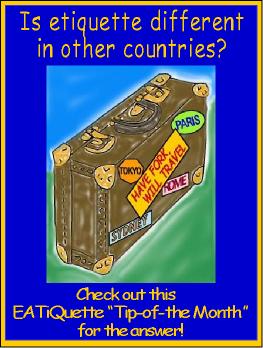 |
Yes, dining etiquette can vary slightly -- or drastically -- depending on the part of the world you're visiting. But don't panic. You don't need to worry about embarrassing yourself or your hosts. If you're polite and respectful, you'll do fine. Ask questions about local dining customs and practices. People will appreciate your attempt to learn about their way of life. You can also learn a lot about the local dining customs by watching your host or hostess and following their cues. A few very general rules to follow:
|
 |
We were recently asked whether dessert wines should be served before, with or after dessert. Because dessert wines such as late harvest rieslings and sauvignon blancs, ice wines and muscats are selected to complement the dessert being served, they should be served at the same time. You could serve the wine instead of sweets, but the dessert fans in your group might be disappointed. Ports, cognacs, grappas (and other digestifs) would be served after dessert. Dessert wines are typically intense in flavor and sometimes higher in alcohol, so pours are generally smaller. Only two or three ounces per person. This is one of the reasons that many dessert wines are sold in half bottles. In some cases, that will also help to keep the cost down -- because of the special production concerns, some dessert wines can be quite pricey. If you're not too familiar with dessert wines, look for restaurants that offer flights (small tastes of several different wines). This is a fun way to learn more about what's available and decide which ones you like. |
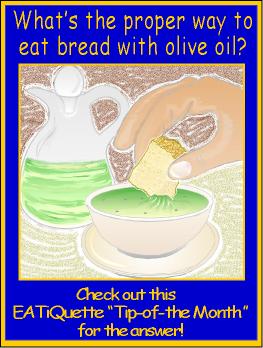 |
Serving plain or flavored olive oils for bread dipping has become very popular both at restaurants and for home dining. But it poses some questions and concerns as to the proper way for a diner to go about the process. The most polite and most sanitary way of dipping is to pour (if the oil is in a bottle or cruet) or spoon (when it's in a bowl or saucer) some of the oil onto your bread and butter plate. Then break off a bite-sized piece of bread and, holding it in your fingers, lightly dip the bread into the oil. Be careful, of course, not to dip your fingertips in, too. Since bread is a finger food, it's not necessary to use a fork. But what do you do when you don't have a bread and butter plate? Or even a spoon to take some oil from the bowl? If you're in a restaurant, ask for what you need. If they don't have bread and butter plates, they should at least be able to find you some kind of small plate or bowl to use. Though you see it being done all the time, everyone in your party dip into the same "community" serving of oil just isn't good etiquette. Especially if there's a "double dipper" in your group! |
 |
Whether it's a business meal, a date or a get-together with family or friends, as a guest, it's sometimes difficult to know what -- and how much -- to order. The best thing to do is to take your cues from your host or hostess. If he or she orders an appetizer, then it's okay for you to have one, too. If your hostess says, "I've had the lobster here and it's superb -- you should try it," then go for it, if you like lobster. When you're counting calories or just don't wish to have any dessert, you don't have to order it just because everyone else does. Use your good judgment so you don't waste food -- or your host's money. Generally, you shouldn't choose the least expensive item on the menu. This might imply that your host or hostess can't afford to treat you to something that costs more. Nor should you choose the most expensive. Try to stay somewhere in the middle, pricewise. |
Return to EATiQuette Home Page
| We welcome your inquiries about our publications and supplemental materials. Please contact Barbara or David Rothschild at: 602.569.2051 or e-mail |
* other tips at removedtips10.html - start with Jun 04